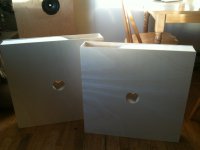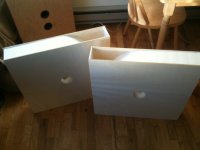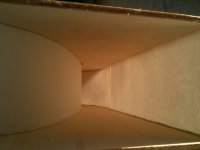I'm wondering how small Cornu spiral could be made with reasonably good results.
Happy New Year All
I have 14 inch x 2 inch deep Cornu's with drivers similar to Visaton FRS5 that I listen to all day. They have a lot of bass (for 2 inch drivers) even when played at low volume. A very rich and full sound from 2 in drivers running on less than a watt of amplifier power. I am very happy with them. I posted a sound clip of how they sound somewhere back in this thread. I suppose the next thing to try is a 1 inch driver - one of those aluminum concave cone deals. I actually stuck one of them into the cutout for the 2 inch driver ( before cutting it to full size) and did notice an immediate bass extension.
Good news, folks: my cornus are all sealed up and ready to go. All I'm waiting for now are the drivers and terminals.  I even bought some wall mounting hardware. Drivers are due to arrive on Thursday, so stay tuned.
I even bought some wall mounting hardware. Drivers are due to arrive on Thursday, so stay tuned.
Attachments
im not sure if this has been asked in the foam core thread, but:
i would like to ask if another material instead of foamcore board is suitable for prototyping a cornu. I access to offcuts of either: 1/ Triwall corrugated board or 2/ that plastic sheet which is used for greenhouse glazing, almost corrugated in construction. Since I can get offcuts free, the idea is appealing. Can you see a good reason why i shouldnt use these other materials?
i would like to ask if another material instead of foamcore board is suitable for prototyping a cornu. I access to offcuts of either: 1/ Triwall corrugated board or 2/ that plastic sheet which is used for greenhouse glazing, almost corrugated in construction. Since I can get offcuts free, the idea is appealing. Can you see a good reason why i shouldnt use these other materials?
It's 1/4" plywood but I don't recall if it's birch; it was the cheapest plywood I could get.Chaz,
Those look really good. Is that quarter inch birch plywood you are using for the panels? Can you refresh my memory what size, depth and drivers you are using?
Chaz,
Your boxes with those drivers and that size looks like it's going to be a really nice combination. I'm really looking forward to hearing your listening impressions. I am wondering whether or not to try a box with 4 equal length horns without any bifurcation. That might be best to try out in all foam core but that will limit the size to 20 in square. I suppose one can use multiple pieces for the faces - not the prettiest thing but for purposes of testing sound may be the way to go in order to make an all foam core unit bigger than 20 inches. I am thinking a 24 x 4 inch size next.
Your boxes with those drivers and that size looks like it's going to be a really nice combination. I'm really looking forward to hearing your listening impressions. I am wondering whether or not to try a box with 4 equal length horns without any bifurcation. That might be best to try out in all foam core but that will limit the size to 20 in square. I suppose one can use multiple pieces for the faces - not the prettiest thing but for purposes of testing sound may be the way to go in order to make an all foam core unit bigger than 20 inches. I am thinking a 24 x 4 inch size next.
Thanks xrk, I'd be lying if I said I wasn't hoping for good results myself! By the way, after the speakers are all assembled I will have them tested for frequency response and phase and report back. That may take a few weeks.
I wonder: if one wanted to try a cornu with a larger driver, is there any consequence to increasing the size of the chamber and thereby reducing the length of the horn besides raising the horn tuning frequency? That would make it possible to fit a larger, say 6.5" or even an 8" driver into a 35" cornu.
I wonder: if one wanted to try a cornu with a larger driver, is there any consequence to increasing the size of the chamber and thereby reducing the length of the horn besides raising the horn tuning frequency? That would make it possible to fit a larger, say 6.5" or even an 8" driver into a 35" cornu.
Chaz,
You can increase the driver size as you say by trimming away the internal channels and reducing the horn length. This will allow you to easily put a 4 inch driver in where a 3 inch used to be. I would not go too far with this as you will be reducing the throat area of the horn relative to the driver piston area Sd as you put larger drivers in there. This may not be a bad thing depending on how the larger driver's T/S parameters behave under a simulation. Some driver chamber compression from a restricted throat may be desirable for better performance and to reduce cone excursion for low Qts/high-BL drivers like Fostex or Lowther. It is easy enough to run a HornResp sim for a simple single horn representing the approximate single Cornu horn geometry and change the throat and length to correspond what happens when you trim the channels to widen the driver chamber. Are you going to be doing the frequency response measurements yourself?
You can increase the driver size as you say by trimming away the internal channels and reducing the horn length. This will allow you to easily put a 4 inch driver in where a 3 inch used to be. I would not go too far with this as you will be reducing the throat area of the horn relative to the driver piston area Sd as you put larger drivers in there. This may not be a bad thing depending on how the larger driver's T/S parameters behave under a simulation. Some driver chamber compression from a restricted throat may be desirable for better performance and to reduce cone excursion for low Qts/high-BL drivers like Fostex or Lowther. It is easy enough to run a HornResp sim for a simple single horn representing the approximate single Cornu horn geometry and change the throat and length to correspond what happens when you trim the channels to widen the driver chamber. Are you going to be doing the frequency response measurements yourself?
What if we made the front face (baffle) out of 2 ft x 2 ft acoustical ceiling tile? What is impact on sound? I was just thinking this could be a very low-visibility ceiling or wall mounted Cornu. If you covered the driver with white speaker grill cloth it would be almost invisible.
http://www.homedepot.com/h_d1/N-5yc1v/R-203170972/h_d2/ProductDisplay?catalogId=10053&langId=-1&keyword=usgs+ceiling+tile&storeId=10051#specifications
http://www.homedepot.com/h_d1/N-5yc1v/R-203170972/h_d2/ProductDisplay?catalogId=10053&langId=-1&keyword=usgs+ceiling+tile&storeId=10051#specifications
I'll be doing the testing with a friend. By the by, we tested my W5 DBRs sometime back and they did exceedingly well.Are you going to be doing the frequency response measurements yourself?
Given that they're porous absorbers, you would find your horn performing quite poorly, most likely.
Yes, but notice how much people try to add porous dampening materials like felt wool, carpet padding, etc to the inside of cabinets. I think the dampening can be tailored by painting with a nonporous paint over the sections that you don't want as much dampening. This stuff is very dense, not like felt or foam but closer to fiberboard. It has the benefit of reducing reflections from the front, and the Cornu is a speaker with a very large baffle area relative to other speaker designs, exceeded maybe by OB's. In fact, one of the complaints about open baffle designs is that they have such a large surface area of reflection in the room. For the Cornu especially, people seem to getting too much peaky bass behavior and this may be beneficial because there is too much bass.
Last edited:
Cal,
What do you mean by ceiling cavity causing too low of a bass cutoff? What about this idea: put the cornu into the false ceiling with only the 24x24 inch ceiling tile face exposed but redirect the horns through slots cut out of ceiling tile? You would have a nice sounding ceiling speaker that is almost invisible. This would mean that cornu would be about 20 inches with say 2 inch wide slots to redirect downwards. The neat thing is that it would be easy to make and try out. I'm sure it would sound better than most ceiling speakers.
What do you mean by ceiling cavity causing too low of a bass cutoff? What about this idea: put the cornu into the false ceiling with only the 24x24 inch ceiling tile face exposed but redirect the horns through slots cut out of ceiling tile? You would have a nice sounding ceiling speaker that is almost invisible. This would mean that cornu would be about 20 inches with say 2 inch wide slots to redirect downwards. The neat thing is that it would be easy to make and try out. I'm sure it would sound better than most ceiling speakers.
Just make it as a regular 24" square, use plywood to mount the drivers, use the ceiling tile and whatever grille cloth over that to disguise it as a regular panel and use the ceiling cavity to disperse the bass.
My concern is that if the bass from the horns is now up in the cavity above the rest of the ceiling tiles that we may need to remove the stuffing from the cornu horns to ensure they don't sound like any other ceiling speakers.
My concern is that if the bass from the horns is now up in the cavity above the rest of the ceiling tiles that we may need to remove the stuffing from the cornu horns to ensure they don't sound like any other ceiling speakers.
Horst Moller uses fibrous ceiling tile to define and line the internals of his back-loaded horns / transmission lines. It apparently reduces / eliminates the requirement for stuffing.
http://http://www.hm-moreart.de/
http://http://www.hm-moreart.de/
Don Hills,
Thanks for the tip about Horst Moller's creations. Ok, so I am onto something... The other advantage of ceiling tile is that it can be cut with a utility knife or a jigsaw cuts it like butter. You may also readily find it for free at building renovation dumpsters
I see that many of the horns on the HM website show internal passages built or lined with ceiling tile, he says it is used to absorb unwanted stuff above 100 Hz.
Thanks for the tip about Horst Moller's creations. Ok, so I am onto something... The other advantage of ceiling tile is that it can be cut with a utility knife or a jigsaw cuts it like butter. You may also readily find it for free at building renovation dumpsters
I see that many of the horns on the HM website show internal passages built or lined with ceiling tile, he says it is used to absorb unwanted stuff above 100 Hz.
Last edited:
Just make it as a regular 24" square, use plywood to mount the drivers, use the ceiling tile and whatever grille cloth over that to disguise it as a regular panel and use the ceiling cavity to disperse the bass.
My concern is that if the bass from the horns is now up in the cavity above the rest of the ceiling tiles that we may need to remove the stuffing from the cornu horns to ensure they don't sound like any other ceiling speakers.
I would redirect horn outputs by making them turn 90 deg towards face so it exits into main room and not false ceiling cavity above tiles.
- Home
- Loudspeakers
- Full Range
- Ever think of building a Cornu Spiral horn? Now you can!


